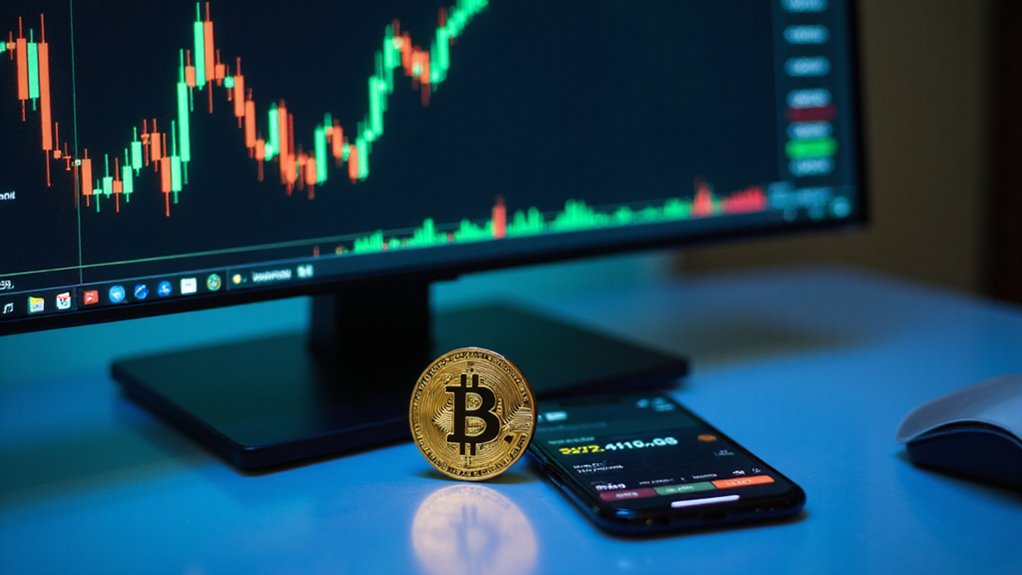Crypto sniping represents a high-velocity trading approach where algorithms execute trades at millisecond speeds to capitalize on fleeting market inefficiencies. Practitioners deploy specialized bots to monitor blockchain mempools, targeting newly listed tokens, liquidity injections, or cross-exchange price discrepancies—essentially turning trading into a computational arms race. While offering tantalizing profit potential for the technically adept, this strategy inhabits a regulatory gray zone fraught with risks including honeypot scams and fierce institutional competition. The financial rewards await those with both technical prowess and steely nerves.

In the shadowy recesses of the cryptocurrency market, a lightning-fast trading strategy has emerged that separates the algorithmic elite from mere mortal traders.
The digital battlefield where milliseconds separate fortunes from failures and algorithms reign supreme over human intuition.
Known as crypto sniping, this approach involves executing trades at millisecond speeds to capitalize on fleeting market inefficiencies that vanish almost as quickly as they appear.
The practice effectively transforms trading into a high-stakes computational arms race, where bots programmed with sophisticated algorithms continuously scan blockchain networks’ mempools—those digital waiting rooms where transactions linger before confirmation—anticipating profitable opportunities before human reflexes could possibly respond.
The sniping ecosystem encompasses several distinct methodologies, each targeting different market anomalies.
Token launch sniping—perhaps the most renowned variant—focuses on newly listed cryptocurrencies, attempting to acquire tokens moments after their debut and before inevitable price surges occur.
Liquidity snipers, meanwhile, patiently monitor for significant capital injections that create favorable trading conditions.
Others employ arbitrage strategies, exploiting price discrepancies across exchanges, or engage in cross-chain maneuvers, simultaneously executing transactions across multiple blockchain networks with mathematical precision. Similar to NFT sniping, these techniques aim to exploit market inefficiencies for obtaining valuable digital assets at lower prices.
Most sniper bots incorporate essential features like honeypot checkers that detect potential scams by identifying fraudulent schemes designed to trap unwary investors.
While crypto sniping presents tantalizing profit potential—particularly for early-movers gaining access to promising tokens before mainstream awareness—it harbors considerable risks that would make traditional financial advisors blanch.
The technical barriers to entry alone are formidable, requiring not just programming acumen but also infrastructure capable of executing commands with near-zero latency.
Even well-designed bots face relentless competition from institutional-grade algorithms, creating a perpetual cycle of diminishing returns as adoption increases.
The strategy shares similarities with Maximal Extractable Value (MEV) extraction, where front-running attacks enable traders to profit at the expense of regular users by manipulating transaction ordering.
More concerning still are the ethical and security considerations.
The strategy exists in a regulatory gray zone, with critics suggesting it undermines market fairness when sophisticated actors consistently front-run average investors.
Moreover, the landscape is rife with deceptive practices—”honeypot” tokens designed explicitly to trap unwary snipers represent just one of many hazards awaiting the overzealous.
For those contemplating this high-velocity trading approach, the adage rings particularly true: extraordinary returns demand extraordinary caution.
Frequently Asked Questions
What Are the Legal Implications of Crypto Sniping?
Crypto sniping operates in a regulatory gray zone where legality hinges on implementation rather than concept.
While not inherently unlawful, sniping practices intersect with securities regulations, market manipulation prohibitions, and jurisdictional variations in automated trading oversight.
The SEC’s scrutiny intensifies when sniped tokens resemble securities, and front-running tactics may violate fair market principles.
Practitioners should note that regulatory bodies increasingly target not just explicit violations but also ethically dubious practices that undermine market integrity.
Can Sniping Lead to Significant Financial Losses?
Sniping can indeed precipitate substantial financial losses through multiple vectors.
Front-running and sandwich attacks frequently leave victims with unfavorable execution prices, while volatile market conditions can rapidly invalidate technical analyses upon which sniping strategies depend.
Perhaps most perilous are new token snipes, where “rug pulls” can vaporize entire investments.
Additionally, accumulated transaction costs—particularly during high network congestion—can quietly erode returns, transforming apparent opportunities into net losses before traders fully comprehend their position’s deterioration.
How Do Sniping Bots Compare to Manual Sniping Methods?
Sniping bots offer unparalleled speed and efficiency, executing trades in milliseconds while monitoring markets 24/7—advantages that manual methods simply cannot match.
However, this automation comes with significant trade-offs: bots lack human intuition, require technical expertise to develop, and remain vulnerable to programming errors.
Manual sniping, while considerably slower, provides greater strategic flexibility, adaptability to unexpected market conditions, and typically involves fewer technical risks than its algorithmic counterpart.
Are Certain Cryptocurrencies More Suitable for Sniping?
Certain cryptocurrencies indeed present more fertile ground for sniping activities.
Newly launched tokens—with their characteristic price volatility—consistently attract snipers seeking dramatic price movements.
Small-cap cryptocurrencies, tokens exhibiting arbitrage opportunities across exchanges, and those possessing high liquidity for swift execution all present prime targets.
Cross-chain compatible assets further expand potential opportunities.
The ideal sniping candidate combines significant price volatility with sufficient liquidity to enter and exit positions without substantial slippage—a delicate balance most seasoned operators recognize instinctively.
What Security Measures Protect Investors From Sniping Attacks?
Security measures against sniping attacks include robust monitoring systems with real-time alerts that flag suspicious transactions, secure API protocols limiting unauthorized access, and enhanced mempool management.
Exchanges implementing surveillance mechanisms and transparent order books create additional safeguards.
Regulatory frameworks—when they actually materialize in the crypto wild west—provide legal recourse for affected investors.
Meanwhile, blockchain optimizations addressing scalability and transaction ordering mitigate exploitation opportunities.
Education remains, perhaps predictably, investors’ most reliable defense against these predatory trading practices.









